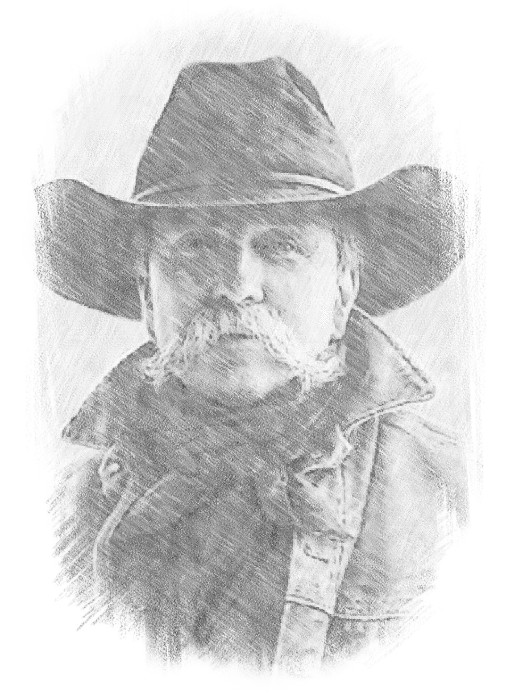
John Coleman, CA Emeritus
(b.1949)
John Coleman was born in Southern California and began his early art studies at the Art Center for Design in Los Angeles. Sculpting full time since 1994, John was voted into professional membership of The National Sculpture Society of New York in 1999.
John was brought into the Cowboy Artist of America in October, 2001, and is a fellow member of the National Sculpture Society. He usually has six or seven works-in-progress at any one time and will introduce four to five new editions each year.
“I am fascinated how music can convey a mood without lyrics and have often thought sculpture lends itself to that idea. I have always loved history and mythology and feel they are the lyrics to my sculpture; the musical interpretation that engages the emotions. Just as music has a beginning, a middle and an end, so does sculpture.
I like to tell stories in my work using metaphors that help explain who we are and from where we came. Creating an object means little to me unless I can portray an underlying emotion or analogy. Each piece tells a story in the three dimensional, a visual mythology written by my hands and spiritual imagination, somehow linking us to the past and bringing us to a greater understanding of our ancestors.”
Source: Coleman Studios
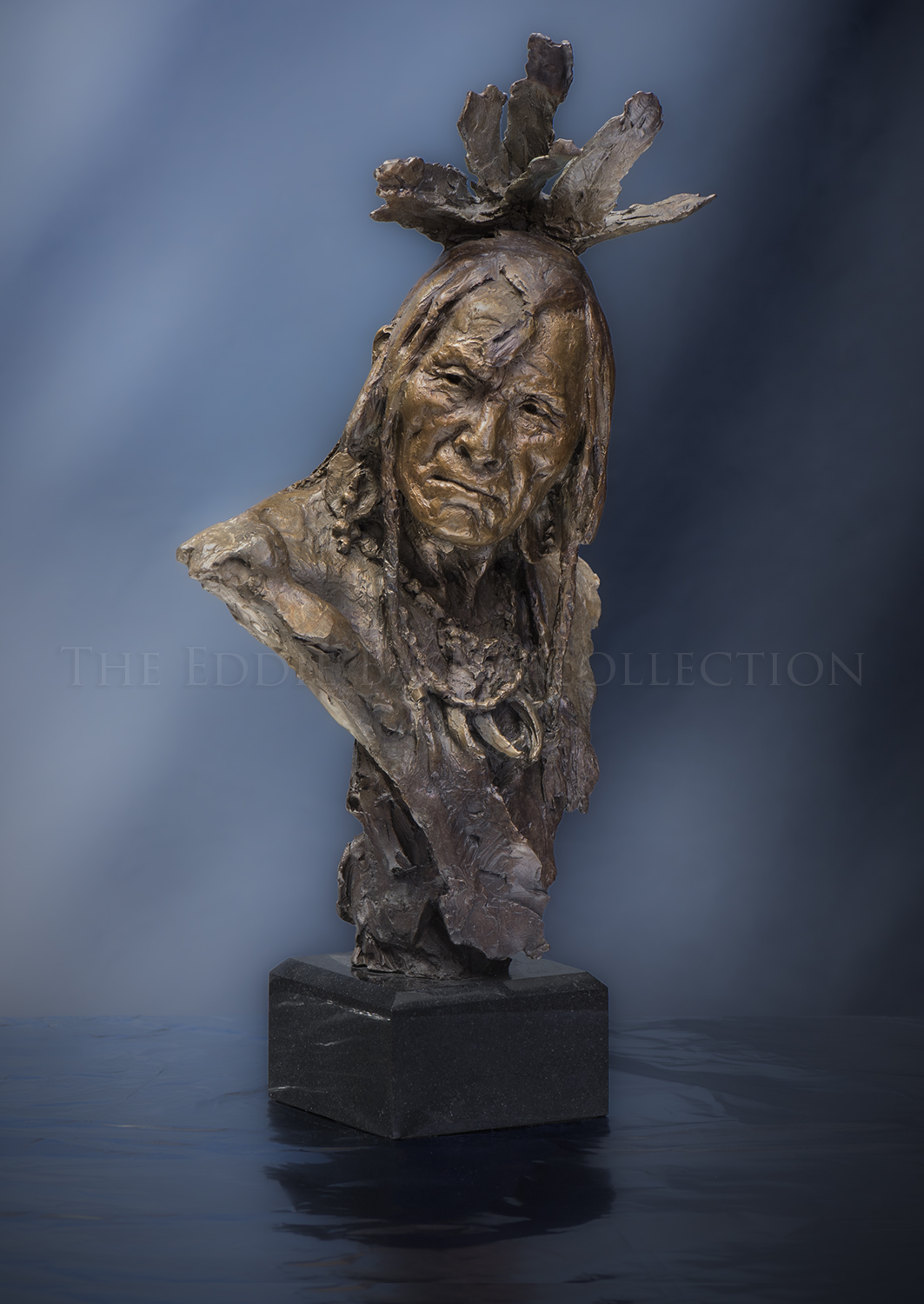
Distant Thunder
Artist: John Coleman, CA Emeritus (b.1949)
Description: Bronze (2003) | Dimensions: 13”h x 7”w x 5”d; Edition #15 of 75bronze
John Coleman’s great sculptural skills are on full display in this bust of a Plains Indian brave. He captures a depth of personality conveying a sense of humanity and dignity in the subject’s face. The tilt of the figure’s head, the look in his eye, and the expression on his face coalesce to impart the essence of the man portrayed.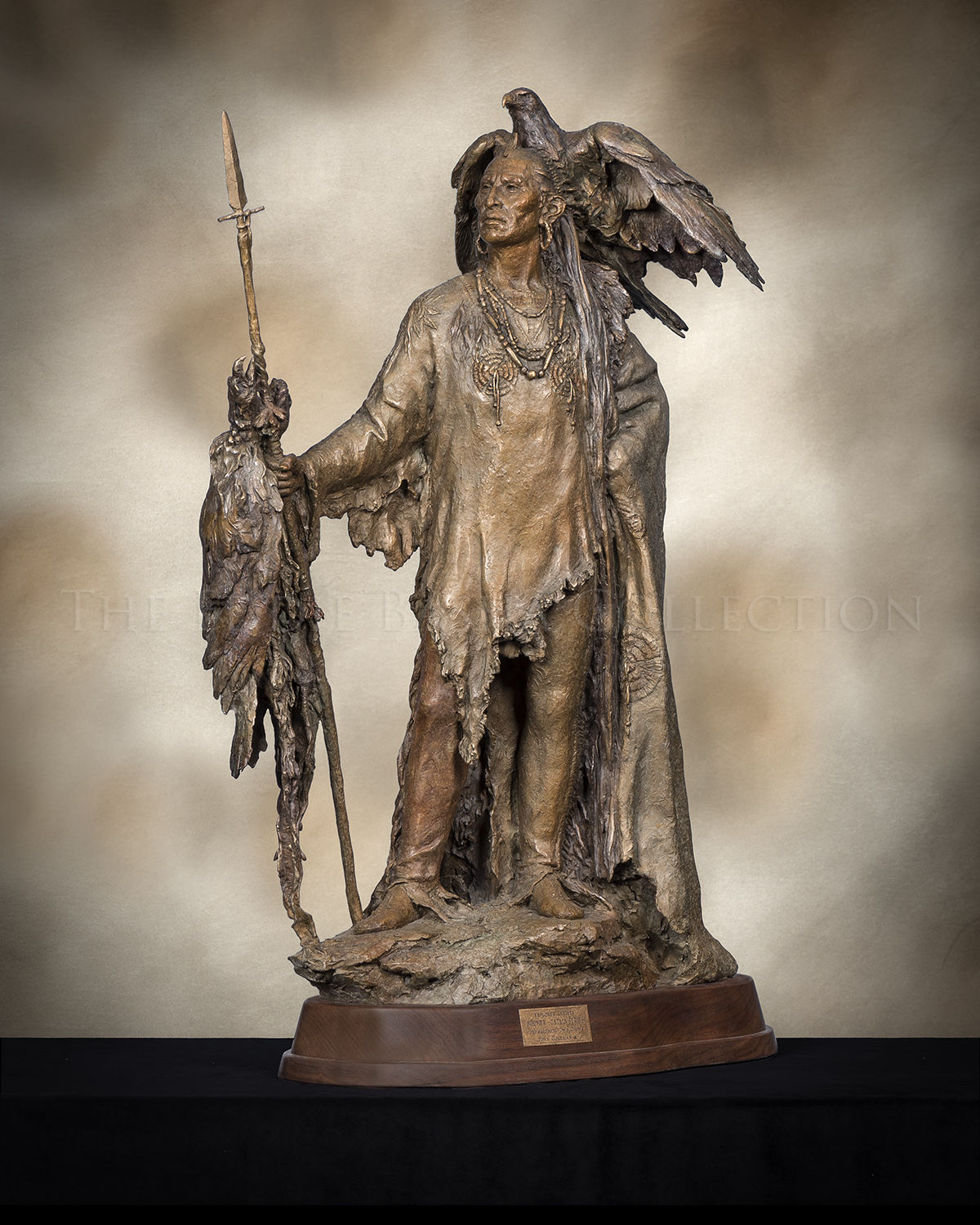
Pariskaroopa, Two Crows
Artist: John Coleman, CA Emeritus (b.1949)
Description: Bronze (2005) | Dimensions: 35”h x 21”w x 11”d; Edition #10 of 35bronze
The Crow Tribe comes from the French derivative of the English name, The Bird People. The Apsaalooke, or Crow, were part of the Hidatsa Tribe until 1776. George Catlin was fascinated by some of the unique physical traits of the tribe noting that most of the men were at least six feet tall and had hair that swept the ground. Part of the daily ritual of the men included grooming their hair with bear grease.
Pariskaroopa was a Band Chief and is the third of a ten-figure series by the award-winning, world-renowned sculptor, John Coleman. He based this collective on the documentaries of historian painters Karl Bodmer and George Catlin. Catlin painted Pariskaroopa in profile to show the crescent shape of his face saying that the shape seemed particular to the Crow. Two Crows is also shown wearing what is said to be a full eagle headdress, probably golden, and has full eagle and otter bags attached to his lance.
“Pariskaroopa, Two Crows” took home the Silver Medal in Sculpture at the 40th Annual Cowboy Artists of America Show & Sale in 2005 held at the Phoenix Art Museum.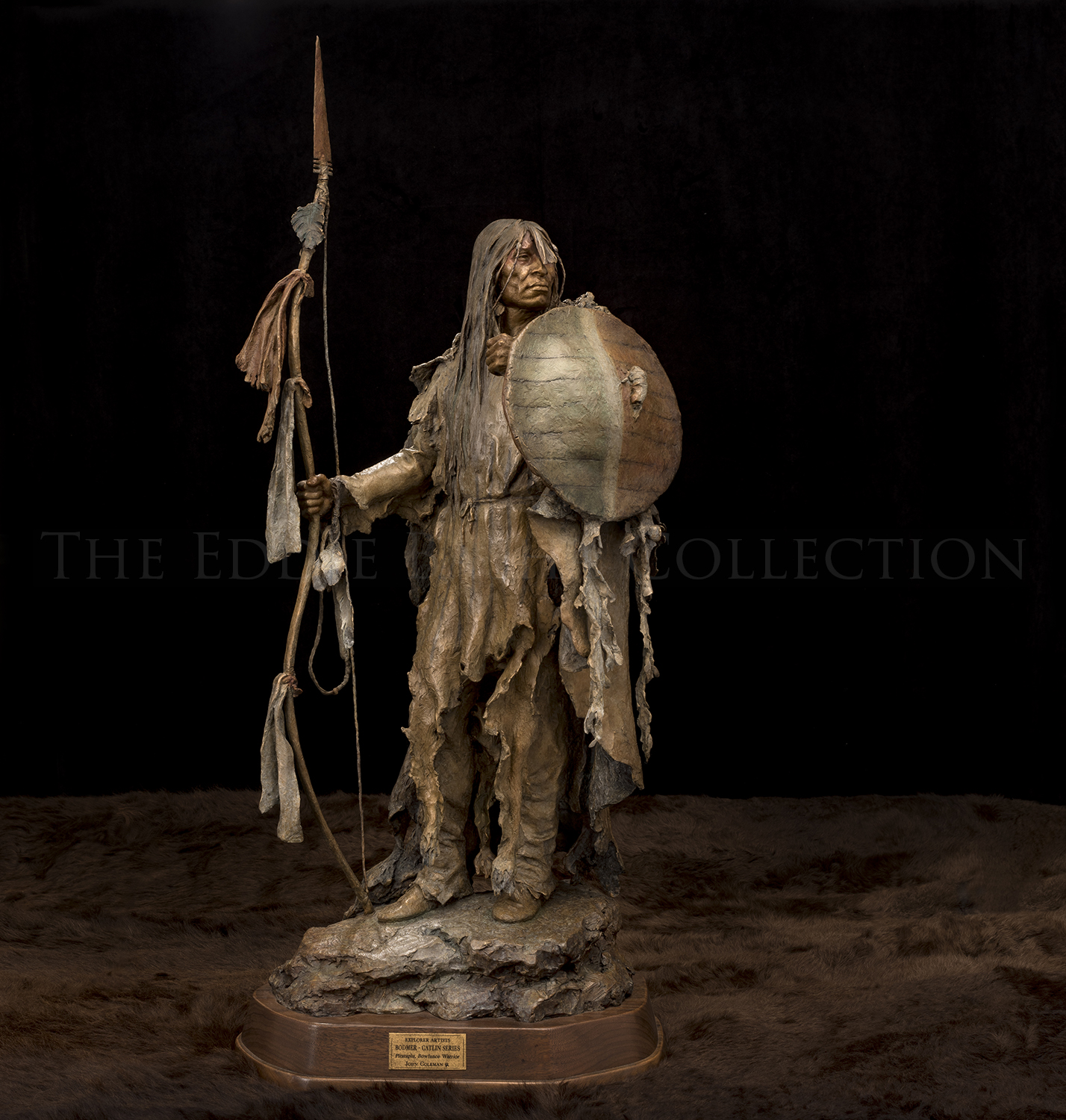
Pitatapiu, Bowlance Warrior
Artist: John Coleman, CA Emeritus (b.1949)
Description: Bronze (2007) | Dimensions: 41”h x 17’W X 12”d; Edition #10 of 35bronze
Source: Colemanstudios.com
Painted by Karl Bodmer at Fort Union in 1833, Pitatapiu was an Assiniboin, a tribe that was once part of the Sioux Nation. A little unusual for the series, Pitatapiu was dressed in warrior clothing instead of his finery for his portrait. He is holding a bowlance, a powerful and special ceremonial accoutrement which signifies that he belongs to an elite society. Possibly the original painting may be the only example of an Indian holding a bowlance which is decorated with bear entrails. In 2007 at the Quest for the West Art Show & Sale at the Eiteljorg Museum of American Indians and Western Art, “Pitatapiu, Bowlance Warrior” won the Cyrus Dallin Award for Best Sculpture. The EBC is pleased to have Edition #10 of 35 in its permanent collection.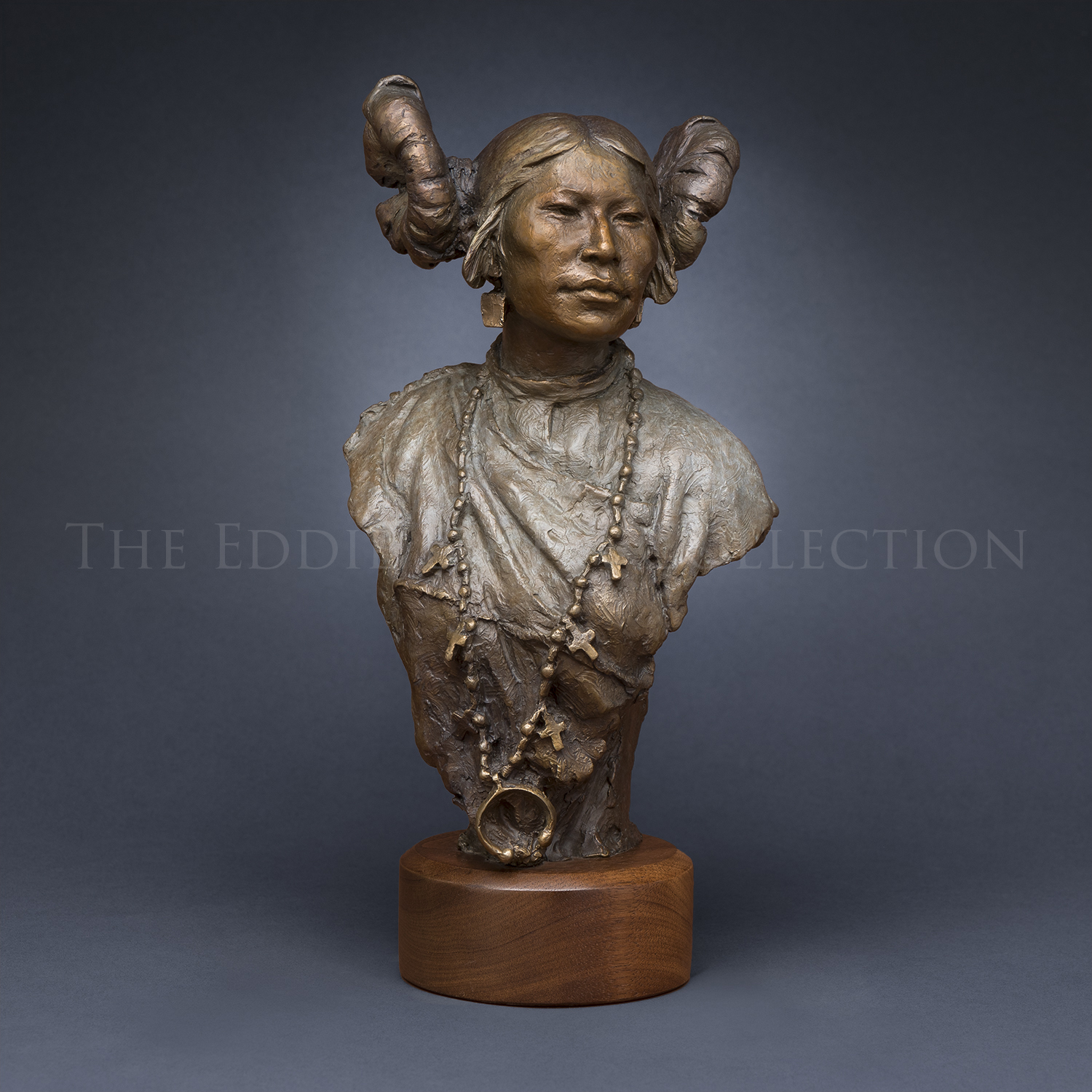
Maiden from the East Mesa
Artist: John Coleman, CA Emeritus (b.1949)
Description: Bronze (2004) | Dimensions: 11”h x 6”w x 4”d; Edition #30 of 75bronze
John Coleman has shown a remarkable ability to capture the spirit and personality of his subjects and also to convey a sense that they are integral parts of a larger culture. His depiction of a Hopi maiden is indicative of his ability to create works of art that have a true humanity.
A Hopi maiden’s hair known as the squash blossom whorl, a fertility symbol, is achieved by wrapping the hair around a wooden mold on each side of one’s head. The mold is removed once the process and desired result is complete.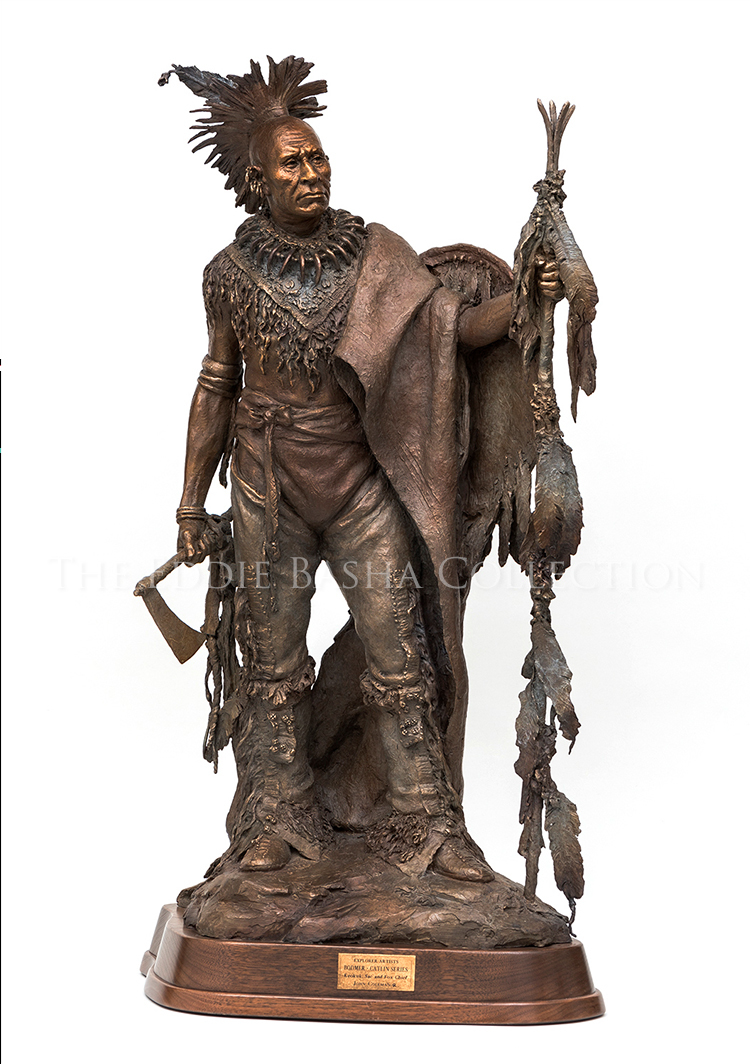
Keokuk, Sac and Fox Chief
Artist: John Coleman, CA Emeritus (b.1949)
Description: Bronze (2004) | 35 ½”h x 18”w x 11”d; Edition #10 of 35bronze
Awarded the Artists’ Choice Award for his body of work at the 39th Annual Cowboy Artists of America Show & Sale in 2004,“Keokuk, Sac and Fox Chief” from John Coleman’s Bodmer-Catlin Bronze Series was among those pieces honored. Of this bronze, Coleman wrote on his website www.colemanstudios.com Keokuk, a Sac and Fox Chief, was known as Watchful Fox and in 1835 he posed for George Catlin. Catlin wrote, “I have represented him in the costume, precisely, in which he was dressed when he stood for it, with his shield on his arm, and his staff (insignia of office) in his left hand. There is no Indian Chief on the frontier better known at this time, or more highly appreciated for his eloquence as a public speaker, than Keokuk.” Perhaps he gained this reputation during a diplomatic mission to Washington D.C.
When Black Hawk aligned himself with the British troops during the war of 1832, Keokuk refused to join him for which he gained recognition and support from the U.S. Government. After Black Hawk was defeated, Keokuk’s people were granted a large tract of land in Southeast Iowa. His grave and statue are in Keokuk, Iowa.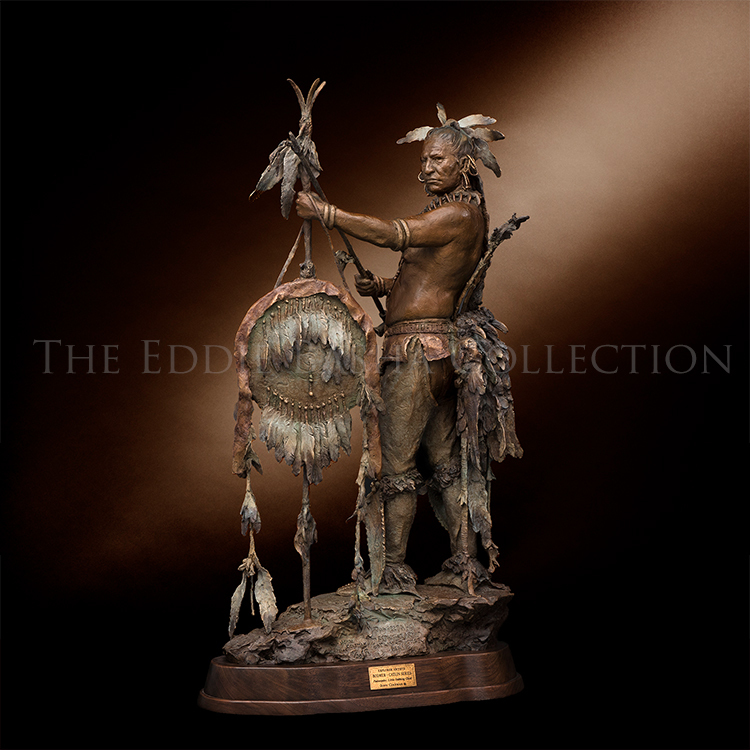
Pasheepaho, Little Stabbing Chief
Artist: John Coleman, CA Emeritus (b.1949)
Description: Bronze | Dimensions: 35”h x 20”w x 11”d; Edition #10 of 35bronze
Artist John Coleman based a series of bronze sculptures on actual paintings by the explorer artists Karl Bodmer and George Catlin. His intent was not to replicate their efforts, but rather to provide his own three dimensional interpretation of the individuals who lived at that time and in those locations. To complete his series, he did exhaustive research on the work of Catlin and Bodmer and of the historical time period and the individuals chronicled. The result is a series of extraordinary sculptures that are authentic in every detail and evocative of individual personalities. The work adds to the historical record created by Bodmer and Catlin and reflects Coleman’s respect for Native American culture and traditions. By refashioning these portraits in three dimensions, Coleman skillfully added details and nuances that the earlier artists could not. Each sculpture is masterfully done with rich and varied patinas. As a complete series and as individual bronzes, Coleman’s remarkable sculptures showcase his many talents.
At the Prairie du Chien treaty signing, Catlin drew Pasheepaho, Little Stabbing Chief, Sac Fox Tribe, who at the time had already resigned his office. He is shown holding his pipe, shield, society staff and wearing a bustle composed of four raven skins, a number that holds symbolic associations for many tribes.
Addih-Hiddisch, Hidatsa
Artist: John Coleman, CA Emeritus (b.1949)
Description: Bronze (2004) | 35”h x 18”w x 11”d; Edition #10 of 35bronze
On his website, www.colemanstudios.com, John Coleman shared that this bronze was the first he sculpted in the Bodmer/Catlin series. It was modeled after the full figure image of Addih-Hiddisch, Hidatsa Chief as painted by Karl Bodmer in 1833. Bodmer also wrote of the Chief that he was a great warrior and that the patterns on his body were tattoos, not paint. He wore a Euro-American hat, carried a trade tomahawk with a scalp lock attached and a peace medal around his neck.
Addih-Hiddisch was a tribal council member, keeper of the great medicine bundle and was remembered one hundred years later by his tribe as an outstanding leader.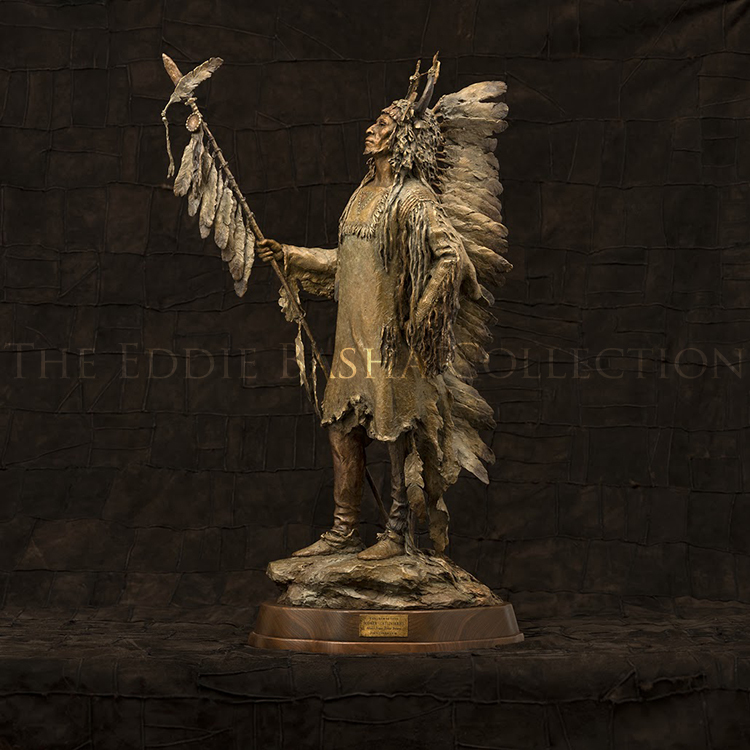
Mato-Tope, Four Bears
Artist: John Coleman, CA Emeritus (b.1949)
Description: Bronze (2005) | 36”h x 23”w x 11”d; Edition #10 of 35bronze
Among sculptor and painter John Coleman’s memorable works are a series of ten bronzes which were based on the paintings, field notes and journals of the artist explorers, Karl Bodmer and George Catlin, who followed the journey of Lewis & Clark. John’s intent was not to replicate the efforts of Bodmer and Catlin, but rather to provide his own three-dimensional interpretation of the period and the individuals who lived in those locations. In many cases, such as with the Mandan tribe, the Bodmer and Catlin works are the only visual records made of those tribes which were decimated by small pox and other diseases and ceased to exist as separate tribal societies shortly after the expeditions. To complete the series, Coleman did his own exhaustive research on the explorer artists’ work, the time period and the individuals they chronicled. Authentic in every detail and reflective of his own feelings and respect for the tribal cultures and traditions of those depicted, each piece is masterfully sculpted and enhanced with varied patinas richly interpreting the subjects.
Among them “Mato-Tope, Four Bears” was modeled after a Karl Bodmer watercolor completed around 1834. “He stood proudly for Bodmer, adorned in his finest clothing with accoutrements that related to past victories of war. The wooden knife in his war bonnet is a reminder of a particular battle that Mato-Tope was involved in with a Cheyenne. The Cheyenne attacked Mato-Tope, wounding his hand, but Mato-Tope was able to disarm him, keeping the knife. The lance he held in his right hand killed an Arikara who had murdered his brother. The lance was also adorned with the scalp of an enemy,” wrote John Coleman.
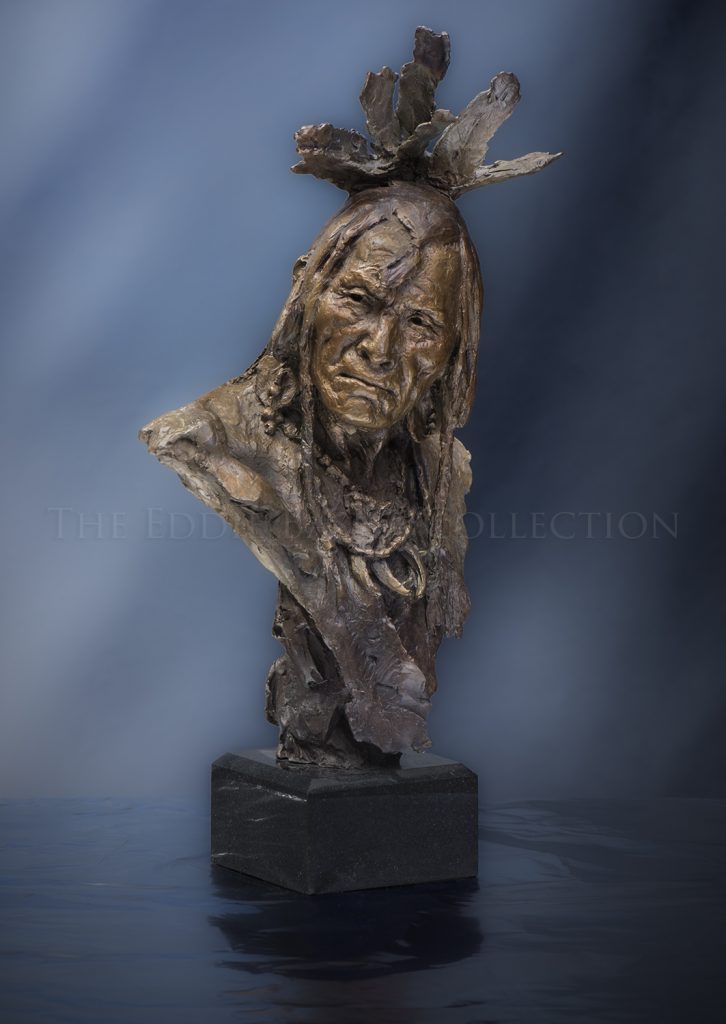 Bronze (2003) | Dimensions: 13”h x 7”w x 5”d; Edition #15 of 75
Bronze (2003) | Dimensions: 13”h x 7”w x 5”d; Edition #15 of 75John Coleman’s great sculptural skills are on full display in this bust of a Plains Indian brave. He captures a depth of personality conveying a sense of humanity and dignity in the subject’s face. The tilt of the figure’s head, the look in his eye, and the expression on his face coalesce to impart the essence of the man portrayed.
Distant Thunder
Artist: John Coleman, CA Emeritus (b.1949)
John Coleman’s great sculptural skills are on full display in this bust of a Plains Indian brave. He captures a depth of personality conveying a sense of humanity and dignity in the subject’s face. The tilt of the figure’s head, the look in his eye, and the expression on his face coalesce to impart the essence of the man portrayed.
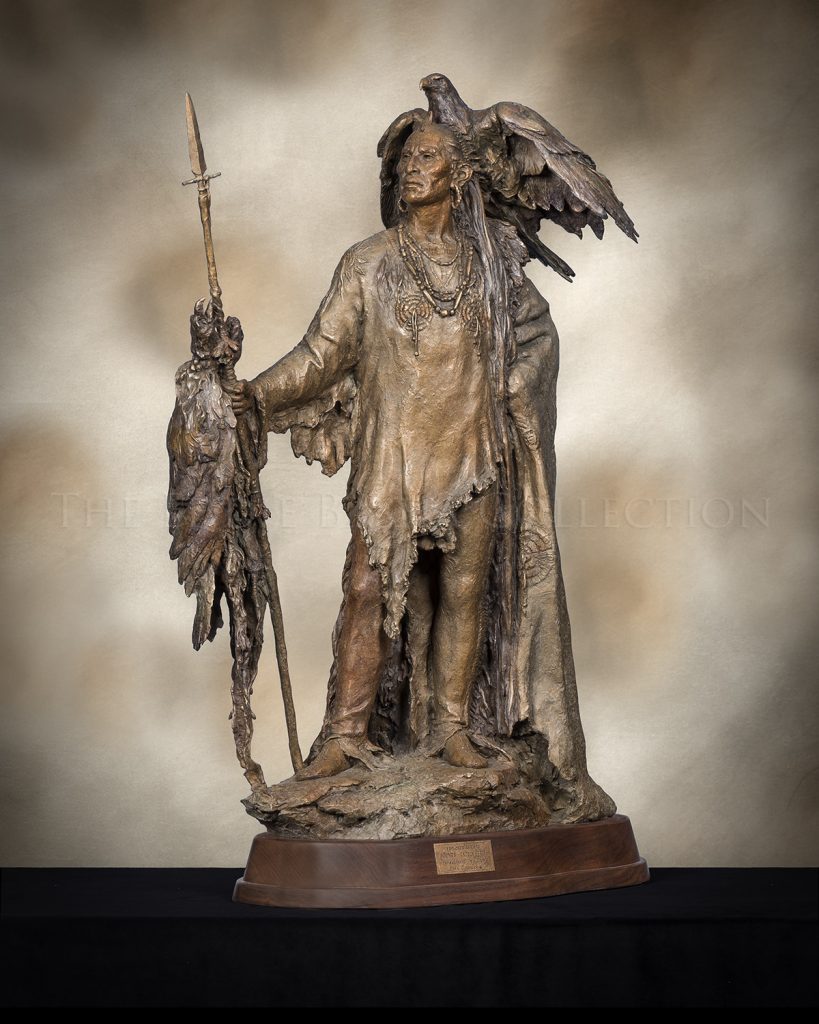 Bronze (2005) | Dimensions: 35”h x 21”w x 11”d; Edition #10 of 35
Bronze (2005) | Dimensions: 35”h x 21”w x 11”d; Edition #10 of 35The Crow Tribe comes from the French derivative of the English name, The Bird People. The Apsaalooke, or Crow, were part of the Hidatsa Tribe until 1776. George Catlin was fascinated by some of the unique physical traits of the tribe noting that most of the men were at least six feet tall and had hair that swept the ground. Part of the daily ritual of the men included grooming their hair with bear grease.
Pariskaroopa was a Band Chief and is the third of a ten-figure series by the award-winning, world-renowned sculptor, John Coleman. He based this collective on the documentaries of historian painters Karl Bodmer and George Catlin. Catlin painted Pariskaroopa in profile to show the crescent shape of his face saying that the shape seemed particular to the Crow. Two Crows is also shown wearing what is said to be a full eagle headdress, probably golden, and has full eagle and otter bags attached to his lance.
“Pariskaroopa, Two Crows” took home the Silver Medal in Sculpture at the 40th Annual Cowboy Artists of America Show & Sale in 2005 held at the Phoenix Art Museum.
Pariskaroopa, Two Crows
Artist: John Coleman, CA Emeritus (b.1949)
The Crow Tribe comes from the French derivative of the English name, The Bird People. The Apsaalooke, or Crow, were part of the Hidatsa Tribe until 1776. George Catlin was fascinated by some of the unique physical traits of the tribe noting that most of the men were at least six feet tall and had hair that swept the ground. Part of the daily ritual of the men included grooming their hair with bear grease.
Pariskaroopa was a Band Chief and is the third of a ten-figure series by the award-winning, world-renowned sculptor, John Coleman. He based this collective on the documentaries of historian painters Karl Bodmer and George Catlin. Catlin painted Pariskaroopa in profile to show the crescent shape of his face saying that the shape seemed particular to the Crow. Two Crows is also shown wearing what is said to be a full eagle headdress, probably golden, and has full eagle and otter bags attached to his lance.
“Pariskaroopa, Two Crows” took home the Silver Medal in Sculpture at the 40th Annual Cowboy Artists of America Show & Sale in 2005 held at the Phoenix Art Museum.
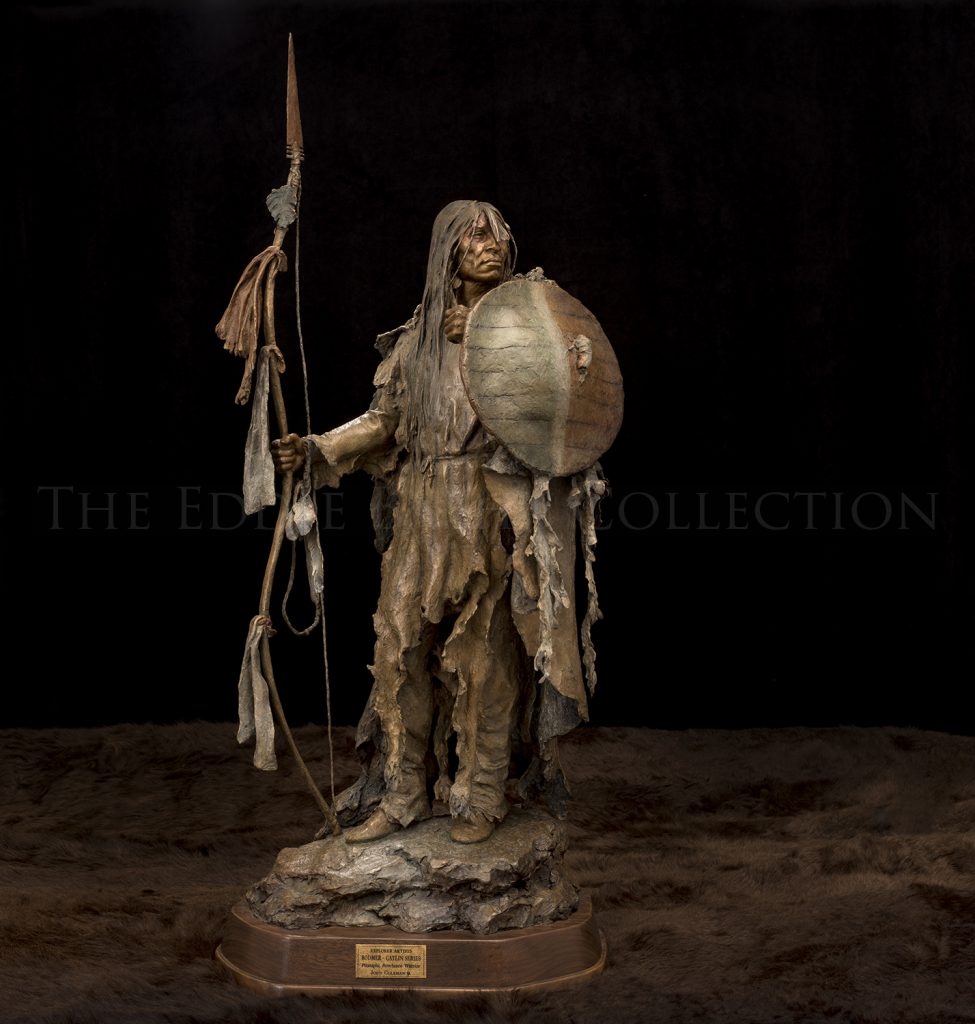 Bronze (2007) | Dimensions: 41”h x 17’W X 12”d; Edition #10 of 35
Bronze (2007) | Dimensions: 41”h x 17’W X 12”d; Edition #10 of 35Source: Colemanstudios.com
Painted by Karl Bodmer at Fort Union in 1833, Pitatapiu was an Assiniboin, a tribe that was once part of the Sioux Nation. A little unusual for the series, Pitatapiu was dressed in warrior clothing instead of his finery for his portrait. He is holding a bowlance, a powerful and special ceremonial accoutrement which signifies that he belongs to an elite society. Possibly the original painting may be the only example of an Indian holding a bowlance which is decorated with bear entrails. In 2007 at the Quest for the West Art Show & Sale at the Eiteljorg Museum of American Indians and Western Art, “Pitatapiu, Bowlance Warrior” won the Cyrus Dallin Award for Best Sculpture. The EBC is pleased to have Edition #10 of 35 in its permanent collection.
Pitatapiu, Bowlance Warrior
Artist: John Coleman, CA Emeritus (b.1949)
Source: Colemanstudios.com
Painted by Karl Bodmer at Fort Union in 1833, Pitatapiu was an Assiniboin, a tribe that was once part of the Sioux Nation. A little unusual for the series, Pitatapiu was dressed in warrior clothing instead of his finery for his portrait. He is holding a bowlance, a powerful and special ceremonial accoutrement which signifies that he belongs to an elite society. Possibly the original painting may be the only example of an Indian holding a bowlance which is decorated with bear entrails. In 2007 at the Quest for the West Art Show & Sale at the Eiteljorg Museum of American Indians and Western Art, “Pitatapiu, Bowlance Warrior” won the Cyrus Dallin Award for Best Sculpture. The EBC is pleased to have Edition #10 of 35 in its permanent collection.
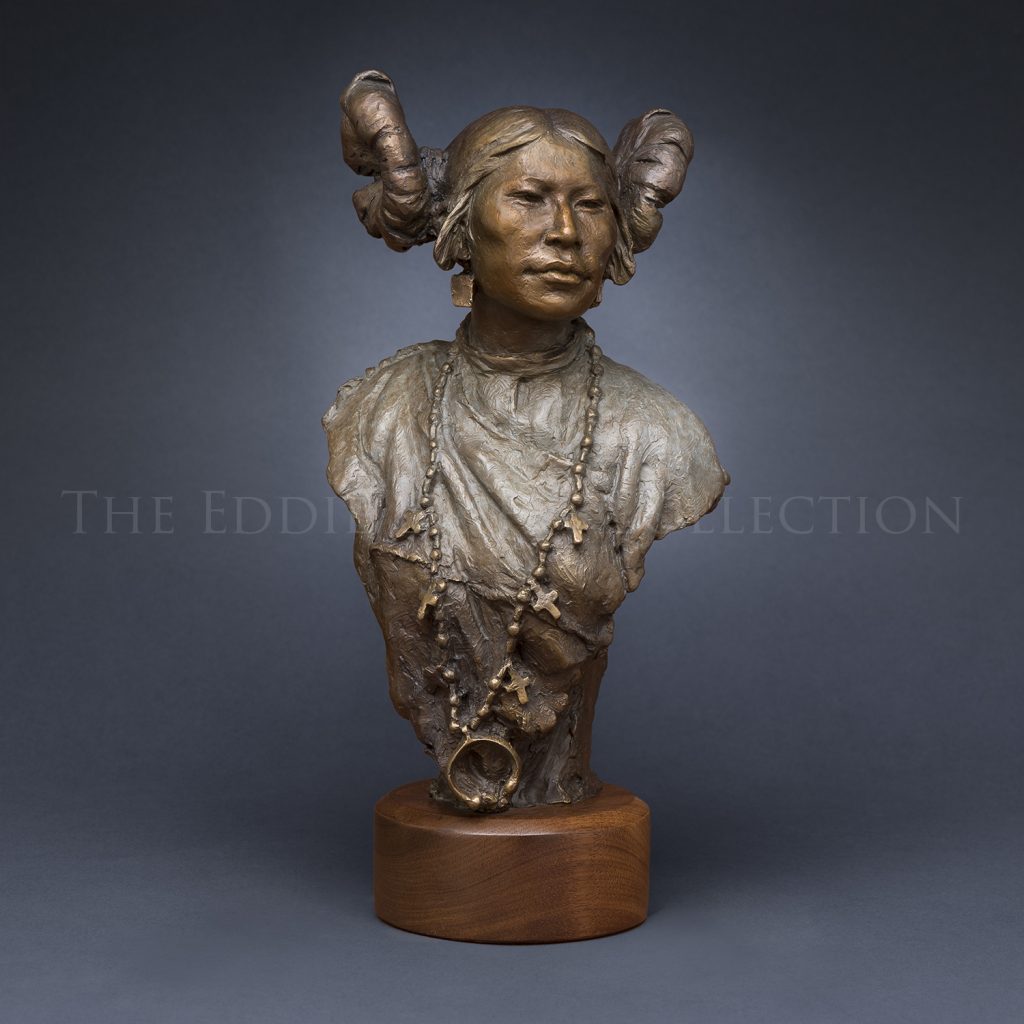 Bronze (2004) | Dimensions: 11”h x 6”w x 4”d; Edition #30 of 75
Bronze (2004) | Dimensions: 11”h x 6”w x 4”d; Edition #30 of 75John Coleman has shown a remarkable ability to capture the spirit and personality of his subjects and also to convey a sense that they are integral parts of a larger culture. His depiction of a Hopi maiden is indicative of his ability to create works of art that have a true humanity.
A Hopi maiden’s hair known as the squash blossom whorl, a fertility symbol, is achieved by wrapping the hair around a wooden mold on each side of one’s head. The mold is removed once the process and desired result is complete.
Maiden from the East Mesa
Artist: John Coleman, CA Emeritus (b.1949)
John Coleman has shown a remarkable ability to capture the spirit and personality of his subjects and also to convey a sense that they are integral parts of a larger culture. His depiction of a Hopi maiden is indicative of his ability to create works of art that have a true humanity.
A Hopi maiden’s hair known as the squash blossom whorl, a fertility symbol, is achieved by wrapping the hair around a wooden mold on each side of one’s head. The mold is removed once the process and desired result is complete.
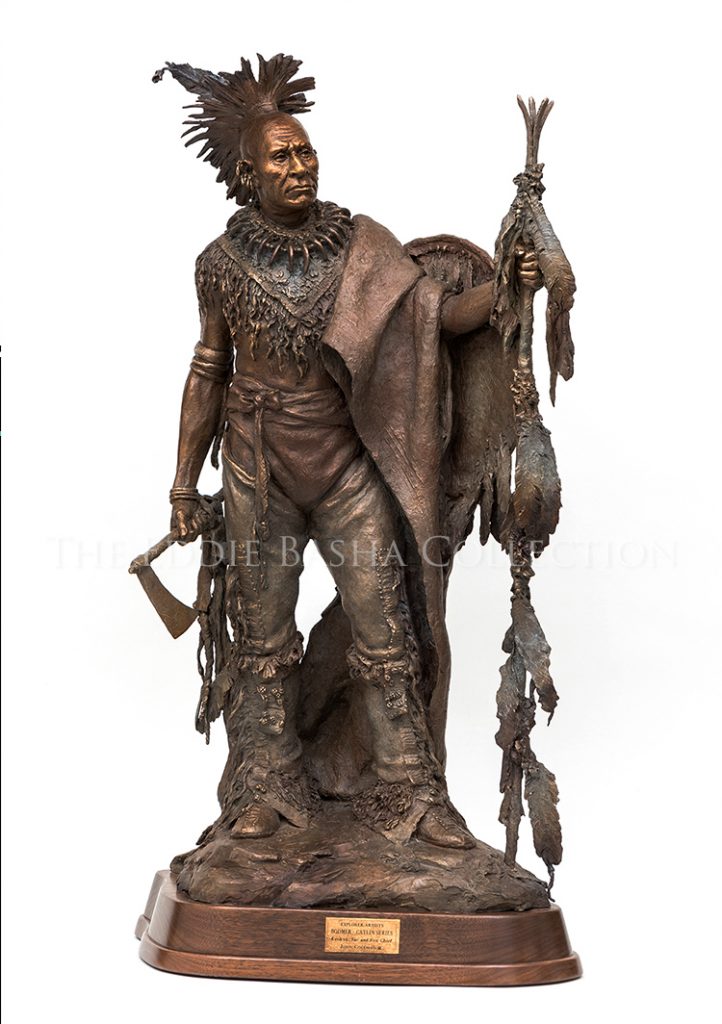 Bronze (2004) | 35 ½”h x 18”w x 11”d; Edition #10 of 35
Bronze (2004) | 35 ½”h x 18”w x 11”d; Edition #10 of 35Awarded the Artists’ Choice Award for his body of work at the 39th Annual Cowboy Artists of America Show & Sale in 2004,“Keokuk, Sac and Fox Chief” from John Coleman’s Bodmer-Catlin Bronze Series was among those pieces honored. Of this bronze, Coleman wrote on his website www.colemanstudios.com Keokuk, a Sac and Fox Chief, was known as Watchful Fox and in 1835 he posed for George Catlin. Catlin wrote, “I have represented him in the costume, precisely, in which he was dressed when he stood for it, with his shield on his arm, and his staff (insignia of office) in his left hand. There is no Indian Chief on the frontier better known at this time, or more highly appreciated for his eloquence as a public speaker, than Keokuk.” Perhaps he gained this reputation during a diplomatic mission to Washington D.C.
When Black Hawk aligned himself with the British troops during the war of 1832, Keokuk refused to join him for which he gained recognition and support from the U.S. Government. After Black Hawk was defeated, Keokuk’s people were granted a large tract of land in Southeast Iowa. His grave and statue are in Keokuk, Iowa.
Keokuk, Sac and Fox Chief
Artist: John Coleman, CA Emeritus (b.1949)
Awarded the Artists’ Choice Award for his body of work at the 39th Annual Cowboy Artists of America Show & Sale in 2004,“Keokuk, Sac and Fox Chief” from John Coleman’s Bodmer-Catlin Bronze Series was among those pieces honored. Of this bronze, Coleman wrote on his website www.colemanstudios.com Keokuk, a Sac and Fox Chief, was known as Watchful Fox and in 1835 he posed for George Catlin. Catlin wrote, “I have represented him in the costume, precisely, in which he was dressed when he stood for it, with his shield on his arm, and his staff (insignia of office) in his left hand. There is no Indian Chief on the frontier better known at this time, or more highly appreciated for his eloquence as a public speaker, than Keokuk.” Perhaps he gained this reputation during a diplomatic mission to Washington D.C.
When Black Hawk aligned himself with the British troops during the war of 1832, Keokuk refused to join him for which he gained recognition and support from the U.S. Government. After Black Hawk was defeated, Keokuk’s people were granted a large tract of land in Southeast Iowa. His grave and statue are in Keokuk, Iowa.
 Bronze | Dimensions: 35”h x 20”w x 11”d; Edition #10 of 35
Bronze | Dimensions: 35”h x 20”w x 11”d; Edition #10 of 35Artist John Coleman based a series of bronze sculptures on actual paintings by the explorer artists Karl Bodmer and George Catlin. His intent was not to replicate their efforts, but rather to provide his own three dimensional interpretation of the individuals who lived at that time and in those locations. To complete his series, he did exhaustive research on the work of Catlin and Bodmer and of the historical time period and the individuals chronicled. The result is a series of extraordinary sculptures that are authentic in every detail and evocative of individual personalities. The work adds to the historical record created by Bodmer and Catlin and reflects Coleman’s respect for Native American culture and traditions. By refashioning these portraits in three dimensions, Coleman skillfully added details and nuances that the earlier artists could not. Each sculpture is masterfully done with rich and varied patinas. As a complete series and as individual bronzes, Coleman’s remarkable sculptures showcase his many talents.
At the Prairie du Chien treaty signing, Catlin drew Pasheepaho, Little Stabbing Chief, Sac Fox Tribe, who at the time had already resigned his office. He is shown holding his pipe, shield, society staff and wearing a bustle composed of four raven skins, a number that holds symbolic associations for many tribes.
Pasheepaho, Little Stabbing Chief
Artist: John Coleman, CA Emeritus (b.1949)
Artist John Coleman based a series of bronze sculptures on actual paintings by the explorer artists Karl Bodmer and George Catlin. His intent was not to replicate their efforts, but rather to provide his own three dimensional interpretation of the individuals who lived at that time and in those locations. To complete his series, he did exhaustive research on the work of Catlin and Bodmer and of the historical time period and the individuals chronicled. The result is a series of extraordinary sculptures that are authentic in every detail and evocative of individual personalities. The work adds to the historical record created by Bodmer and Catlin and reflects Coleman’s respect for Native American culture and traditions. By refashioning these portraits in three dimensions, Coleman skillfully added details and nuances that the earlier artists could not. Each sculpture is masterfully done with rich and varied patinas. As a complete series and as individual bronzes, Coleman’s remarkable sculptures showcase his many talents.
At the Prairie du Chien treaty signing, Catlin drew Pasheepaho, Little Stabbing Chief, Sac Fox Tribe, who at the time had already resigned his office. He is shown holding his pipe, shield, society staff and wearing a bustle composed of four raven skins, a number that holds symbolic associations for many tribes.
 Bronze (2004) | 35”h x 18”w x 11”d; Edition #10 of 35
Bronze (2004) | 35”h x 18”w x 11”d; Edition #10 of 35On his website, www.colemanstudios.com, John Coleman shared that this bronze was the first he sculpted in the Bodmer/Catlin series. It was modeled after the full figure image of Addih-Hiddisch, Hidatsa Chief as painted by Karl Bodmer in 1833. Bodmer also wrote of the Chief that he was a great warrior and that the patterns on his body were tattoos, not paint. He wore a Euro-American hat, carried a trade tomahawk with a scalp lock attached and a peace medal around his neck.
Addih-Hiddisch was a tribal council member, keeper of the great medicine bundle and was remembered one hundred years later by his tribe as an outstanding leader.
Addih-Hiddisch, Hidatsa
Artist: John Coleman, CA Emeritus (b.1949)
On his website, www.colemanstudios.com, John Coleman shared that this bronze was the first he sculpted in the Bodmer/Catlin series. It was modeled after the full figure image of Addih-Hiddisch, Hidatsa Chief as painted by Karl Bodmer in 1833. Bodmer also wrote of the Chief that he was a great warrior and that the patterns on his body were tattoos, not paint. He wore a Euro-American hat, carried a trade tomahawk with a scalp lock attached and a peace medal around his neck.
Addih-Hiddisch was a tribal council member, keeper of the great medicine bundle and was remembered one hundred years later by his tribe as an outstanding leader.
 Bronze (2005) | 36”h x 23”w x 11”d; Edition #10 of 35
Bronze (2005) | 36”h x 23”w x 11”d; Edition #10 of 35Among sculptor and painter John Coleman’s memorable works are a series of ten bronzes which were based on the paintings, field notes and journals of the artist explorers, Karl Bodmer and George Catlin, who followed the journey of Lewis & Clark. John’s intent was not to replicate the efforts of Bodmer and Catlin, but rather to provide his own three-dimensional interpretation of the period and the individuals who lived in those locations. In many cases, such as with the Mandan tribe, the Bodmer and Catlin works are the only visual records made of those tribes which were decimated by small pox and other diseases and ceased to exist as separate tribal societies shortly after the expeditions. To complete the series, Coleman did his own exhaustive research on the explorer artists’ work, the time period and the individuals they chronicled. Authentic in every detail and reflective of his own feelings and respect for the tribal cultures and traditions of those depicted, each piece is masterfully sculpted and enhanced with varied patinas richly interpreting the subjects.
Among them “Mato-Tope, Four Bears” was modeled after a Karl Bodmer watercolor completed around 1834. “He stood proudly for Bodmer, adorned in his finest clothing with accoutrements that related to past victories of war. The wooden knife in his war bonnet is a reminder of a particular battle that Mato-Tope was involved in with a Cheyenne. The Cheyenne attacked Mato-Tope, wounding his hand, but Mato-Tope was able to disarm him, keeping the knife. The lance he held in his right hand killed an Arikara who had murdered his brother. The lance was also adorned with the scalp of an enemy,” wrote John Coleman.
Mato-Tope, Four Bears
Artist: John Coleman, CA Emeritus (b.1949)
Among sculptor and painter John Coleman’s memorable works are a series of ten bronzes which were based on the paintings, field notes and journals of the artist explorers, Karl Bodmer and George Catlin, who followed the journey of Lewis & Clark. John’s intent was not to replicate the efforts of Bodmer and Catlin, but rather to provide his own three-dimensional interpretation of the period and the individuals who lived in those locations. In many cases, such as with the Mandan tribe, the Bodmer and Catlin works are the only visual records made of those tribes which were decimated by small pox and other diseases and ceased to exist as separate tribal societies shortly after the expeditions. To complete the series, Coleman did his own exhaustive research on the explorer artists’ work, the time period and the individuals they chronicled. Authentic in every detail and reflective of his own feelings and respect for the tribal cultures and traditions of those depicted, each piece is masterfully sculpted and enhanced with varied patinas richly interpreting the subjects.
Among them “Mato-Tope, Four Bears” was modeled after a Karl Bodmer watercolor completed around 1834. “He stood proudly for Bodmer, adorned in his finest clothing with accoutrements that related to past victories of war. The wooden knife in his war bonnet is a reminder of a particular battle that Mato-Tope was involved in with a Cheyenne. The Cheyenne attacked Mato-Tope, wounding his hand, but Mato-Tope was able to disarm him, keeping the knife. The lance he held in his right hand killed an Arikara who had murdered his brother. The lance was also adorned with the scalp of an enemy,” wrote John Coleman.